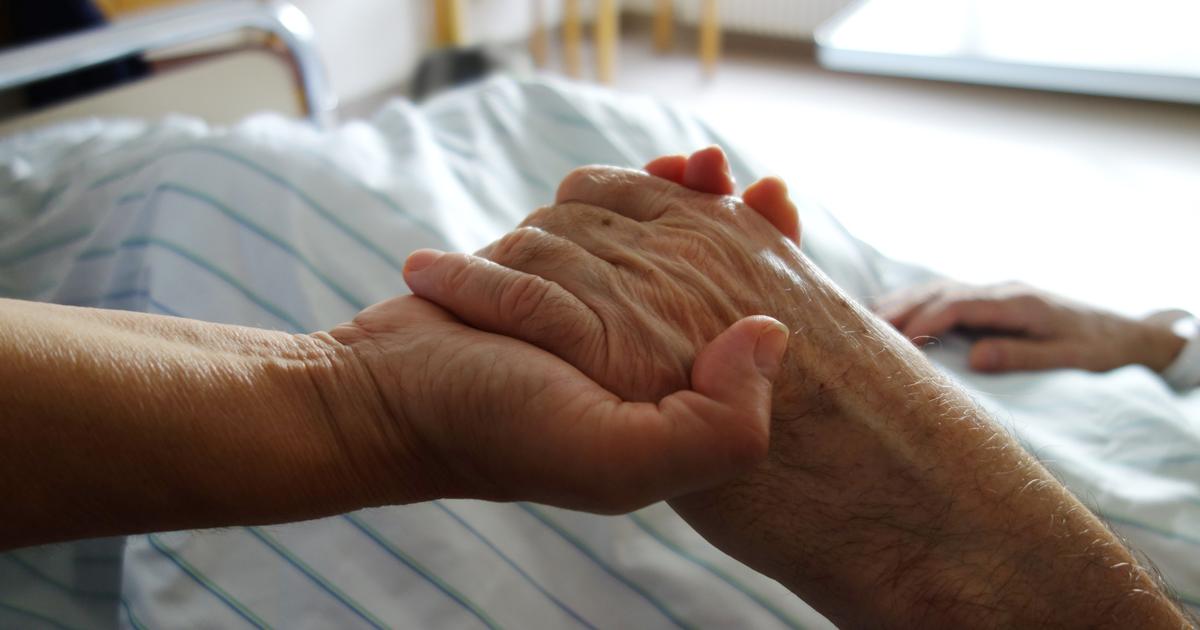A terminally ill woman receives treatment at her home in Apatzingán, in the state of Michoacán.Kuni Takahashi (Getty Images)
The pain starts on the right side of her belly and slowly spreads to the rest of her body, until she is almost paralyzed.
Nora Robles Villaseñor, 66, has terminal cancer in her right kidney that doctors tried to fight with three different types of chemotherapy.
None of the treatments worked.
To alleviate the pain, it would be normal to go regularly to a hospital to receive injections of liquid morphine or any other opioid, but in Guadalajara, Jalisco, as in many other parts of the country, there are hardly any supplies left.
Guillermo Arechiga, her doctor and president of the Jalisco Association of Palliative Medicine (AJMP), has launched an alert to warn about the lack of these medications.
According to the association, the federal government has reduced the purchase of opioids by 40% since 2017,
needed to care for the more than 600,000 patients suffering from chronic pain in the country.
The result is that, as Arechiga says: "In this country you die badly."
Given the absence of morphine in the bag, Arechiga prescribed one of the alternatives to Robles: morphine patches that cost around 1,770 pesos per box with four units.
She, with a pension from a retired university professor, could not afford them, and she has had to receive help from her family.
“At Christmas I told my children and my brothers not to give me anything, that they better save money to buy me some patches,” Robles said, in a tired voice, on the other end of the phone.
The patches worked for a few months, but Robles' body has generated a tolerance to the medication and this, together with the increase in the cancerous mass, has caused the pain to return, which begins in the kidney and gradually spreads to the rest of the body. body until she was almost paralyzed.
Arechiga, a specialist in palliative care, attended her last week at the Hospital General Occidente, in Guadalajara, Jalisco.
To alleviate a bit of the pain that she has dying, she is now giving her oxycodone.
“It is what we have at the moment, from a donation that they made to us and that expires in August,” she said by phone.
This case, far from being the exception in Mexico, reveals the failures that have existed for years in the health system, unable to alleviate the chronic pain of its patients.
The Arechiga association denounces that the shortage of opioids affects the entire country.
"We have been in contact with Sinaloa, Baja California and other states that confirmed the same deficiencies," lamented the doctor.
The solution, until now, is an unwritten policy that consists of prescribing the medicine that is available in the pharmacy, instead of the one that can most benefit the patient.
At the time of publishing this article, the Ministry of Health has not responded to attempts to contact this newspaper.
Dr. Ángel Manuel Juárez, president of the Mexican Association for the Study and Treatment of Pain (AMETD) says that, on many occasions,
he prescribes an opioid to his patients and, after a few hours, they return to the office because they were out of stock at the pharmacy.
"One month there is no buprenorphine [a widely used opioid] and I have to change the prescription to oxycodone or whatever is in the pharmacies that month," says the doctor.
What is the opioid you prescribe the most?
—The one I prescribe the most is the one there is.
But it shouldn't be like that.
It is a disaster, a medicine based on existence, instead of evidence.
The difficulties in accessing opioids generate a pain epidemic in Mexico that silently affects millions of people.
There are 600,000 Mexicans who suffer acute and severe pain, and only 5% have access to palliative care, according to figures collected by the AEMTD.
The Institute for Advanced Studies of the Americas, in an investigation carried out together with the University of Miami, determined that more than 500,000 Mexicans die each year with suffering derived from their health problems.
Experts argue that if something is not done to fix the shortage, this figure will continue to rise, especially if other structural problems are taken into account.
"But nothing is done," says Arechiga, "because the pain of others is the best tolerated, until it's your turn."
Juárez, who began in the specialty of anesthesiology before specializing in palliative care, lists the problems that exist until he runs out of breath.
Palliative care is not taught in medical schools, government regulation is too strict, most hospitals do not have pain clinics —many closed due to the pandemic and have not reopened—, in the provinces, apart from Guadalajara, Monterrey and Mexico City, there are no pharmacies that supply the drugs, so patients have to travel to the capitals to get them, but if they are in a lot of pain, this simple task can become a chimera... and a long etcetera.
“People die in pain and we often can't do anything.
It is as if I devoted myself to writing and there were no liberations in the entire country,” says Juárez.
María Elizabeth de los Ríos Uriarte, doctor of philosophy and professor of bioethics at the Anahuac University, explains that the fundamental error is printed in the law.
Article 166 of the General Health Law determines, with regard to palliative care, that the terminally ill is one who has a life expectancy of "less than six months of life."
“But palliative care is not end-of-life care.
When you are diagnosed with a disease that has no cure, such as terminal cancer, but also diabetes or HIV, you have to intervene from the beginning so that the patient can have a dignified and pain-free life for as long as possible”, defends the doctor.
“In Mexico we have made a lot of progress, but there is still a lot to do,” says De los Ríos.
—How do patients react when you relieve their pain?
—It's nice —says Arechiga—, the relatives continue to remember you as someone who accompanied the patient, even though the patient has died.
It's about having a compassionate approach, I care about you and I listen to you and I shake your hand and we believe in God together, if that's what you need.
When people die well, with their families, without suffering, fixing their earrings... it's different.
And I'm sorry if by protesting and asking for medicine we offend the powerful, but we do it in the name of those who suffer.
subscribe here
to the EL PAÍS México
newsletter
and receive all the key information on current affairs in this country
Subscribe to continue reading
Read without limits
Keep reading
I'm already a subscriber





/cloudfront-eu-central-1.images.arcpublishing.com/prisa/BS6KLR7HWVHDBPE2NL7LDTVNKE.jpg)



